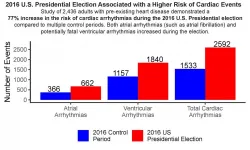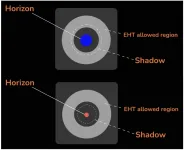(Press-News.org) NEW YORK, NY (May 20, 2021)--The immune nature of kidney cancer stands out when compared to other cancers: More immune cells infiltrate kidney cancers than most other solid tumors, and kidney cancer is one of the most responsive malignancies to today's immunotherapy regimens.
But despite treatment, many patients with clear cell renal carcinoma--the most common type of kidney cancer--eventually relapse and develop incurable metastatic disease.
A new study shows that the presence of a rare and previously unknown type of immune cell in kidney tumors can predict which patients are likely to have cancer recur after surgery. These cells could even be driving aggressive disease.
"Our findings suggest that the presence of these cells could be used to identify patients at high risk of disease recurrence after surgery who may be candidates for more aggressive therapy," says co-senior author Charles Drake, MD, PhD, adjunct professor of medicine at Columbia University Vagelos College of Physicians and Surgeons and the Herbert Irving Comprehensive Cancer Center.
The study was published online May 20 in the journal Cell. Andrea Califano, Dr, the Clyde and Helen Wu Professor of Chemical and Systems Biology and chair of systems biology at Columbia University Vagelos College of Physicians and Surgeons, also is co-senior author of the study.
New Tools Tapped to Profile Cells
Though kidney tumors are densely infiltrated by immune cells, cell subtypes and their association with post-surgical outcomes have remained largely unknown.
It's like looking down at Manhattan and seeing that large numbers of people from all over travel into the city every morning, says Aleksandar Obradovic, an MD/PhD student at Columbia University Vagelos College of Physicians and Surgeons and the study's co-first author. "To understand how these diverse commuters are interacting with Manhattan residents, we need finer details: Who are they; what are they like, where do they go, and what are they doing?"
To uncover the fine details of the immune cells that infiltrate kidney cancers, the researchers combined two of the newest techniques in cancer research.
The first, called single-cell RNA sequencing, captures a snapshot of gene activity in individual cells within a tumor. This high-throughput technique allows researchers to obtain such snapshots inside of tens of thousands of cells from one tumor in a single experiment, providing insights into the identity and behavior of the various cell types.
This powerful technique can identify new types of cells, but there is a drawback. Because single-cell sequencing works by detecting a small number of mRNA molecules inside each cell, it often fails to detect the mRNAs of genes with low expression levels, including key signaling genes and drug targets such as immunotherapy checkpoints.
"In many experiments, single-cell RNA sequencing misses up to 90% of gene activity, a phenomenon known as gene dropout," Obradovic says.
Prediction Algorithm Addresses Gene Dropout
The researchers addressed gene dropout by developing a prediction algorithm that can infer which genes are active by looking at the expression of other related genes. "Even when a lot of the data are missing due to dropout, we still have enough clues to infer the activity of the upstream regulator gene," Obradovic says. "It's like playing 'Wheel of Fortune': I can usually guess what's on the board even when most of the letters are missing."
The algorithm, called meta-VIPER, builds on the VIPER algorithm developed in the Califano laboratory. Califano is also director of the JP Sulzberger Columbia Genome Center in the Herbert Irving Comprehensive Cancer Center.
With the addition of metaVIPER, the researchers estimate they can accurately detect the activity of 70% to 80% of all regulatory genes in each cell, eliminating dropout across cells.
Patient Outcomes Track with Newly Identified Macrophages
This combined approach was used to analyze more than 200,000 tumor cells and normal cells in adjacent tissue taken from 11 patients with clear cell renal carcinoma who underwent surgery in the Department of Urology at Columbia.
The analysis revealed a unique sub-population of immune cells called macrophages found only in tumors and associated with eventual relapse of disease after initial treatment. The VIPER analysis also revealed the top genes (or master regulators) that control the activity of these macrophages. This "signature" was validated in a second set of patient data obtained through a collaboration with researchers from Vanderbilt University; here the signature strongly predicted relapse in a second set of over 150 patients.
Furthermore, these macrophages were found to interact directly with tumor cells through receptor-ligand gene pairs. "These data raise the intriguing possibility that these macrophages are not just markers of more risky disease but may actually cause the disease to recur and progress," Obradovic says, "and that targeting these cells could improve clinical outcomes."
Thus VIPER-based technologies, such as Oncotreat test, could be used to identify drugs targeting these rare but critical subpopulations, thus preventing the poor outcomes associated with their presence, Califano says.
Techniques Could Be Applied to Other Cancers and Diseases
The combination single-cell sequencing with the VIPER algorithm has potential to dissect other types of cancer too, the researchers say.
"Our study demonstrates that the two techniques, when combined, are highly effective at characterizing the cells within a tumor and in surrounding tissues and should have broad applicability, even beyond the study of cancer," Drake says.
INFORMATION:
More Information
The study is titled "Single-Cell Protein Activity Analysis Identifies Recurrence-Associated Renal Tumor Macrophages."
Charles Drake is employed by Johnson & Johnson.
The other contributors: Nivedita Chowdhury (Columbia), Scott M. Haake (Vanderbilt University Medical Center, Nashville TN), Casey Ager (Columbia), Vinson Wang (Columbia), Lukas Vlahos (Columbia), Xinzheng V. Guo (Columbia), David H. Aggen (Columbia), W. Kimryn Rathmell (Vanderbilt), Eric Jonasch (MD Anderson Cancer Center, Houston TX), Joyce E. Johnson (Vanderbilt), Marc Roth (Vanderbilt), Kathryn E. Beckermann (Vanderbilt), Brian I. Rini (Vanderbilt), and James McKiernan (Columbia).
This research was supported by grants from the National Institutes of Health (R01 CA127153, 1P50CA58236-15, P30CA006973, R35 CA197745, U01DA217858, S10 OD012351, S10 OD021764, and R38 CA231577).
The authors report the following potential conflicts of interest: Drake is a co-inventor on patents licensed from JHU to BMS and Janssen, has served as a paid consultant to AZ Medimmune, BMS, Pfizer, Roche, Sanofi Aventis, Genentech, Merck, and Janssen, and has received sponsored research funding to his institution from the Bristol-Myers Squibb International Immuno-Oncology Network and Janssen. Califano is founder, equity holder, consultant, and director of DarwinHealth Inc., a company that has licensed some of the algorithms used in this manuscript from Columbia University. Columbia University is also an equity holder in DarwinHealth Inc. Rini has served as a paid consultant to BMS, Pfizer, GNE/Roche, Aveo, Synthorx, Compugen, Merck, Corvus, Surface Oncology, 3DMedicines, Arravive, Alkermes, Arrowhead, GSK, and Shionogi and holds stock in PTC Therapeutics.
We observe water vapor condensing into liquid droplets on a daily basis, be it as dew drops on leaves or as droplets on the lid of a cooking pot. Since the work of Dutch physicist J.D. van der Waals in the 19th century, condensation has been understood to result from attractive forces between the molecules of a fluid.
Now, an international team of researchers has discovered a new mechanism of condensation: Even if they don't attract each other, self-propelled particles can condense by turning toward dense regions, where they accumulate. The study was published in Nature Physics.
"It's like if cars steered toward crowded areas and made the crowd even bigger," explained Steve Granick, director of the IBS Center for Soft and Living ...
Antiretroviral therapy, the common approach in the treatment of HIV, halts replication of the virus and has saved the lives of millions of people. However, for patients the drug cocktail becomes a lifetime necessity because they continue to harbor latent HIV in a small number of immune system cells. In the absence of treatment, HIV can again replicate and rebound into full blown AIDs.
A new study, however, suggests that addition of a single small molecule can rip away the cloak that shields those cells containing HIV and make them susceptible the patient's own antibodies that otherwise are not normally of much use against HIV.
For the study, a team of researchers ...
HOUSTON - Researchers at The University of Texas MD Anderson Cancer Center have developed a first-of-its-kind artificial intelligence (AI)-based tool that can accurately identify rare groups of biologically important cells from single-cell datasets, which often contain gene or protein expression data from thousands of cells. The research was published today in Nature Computational Science.
This computational tool, called SCMER (Single-Cell Manifold presERving feature selection), can help researchers sort through the noise of complex datasets to study cells that would likely not be identifiable otherwise.
SCMER may be used broadly for many applications in oncology and beyond, explained senior author Ken Chen, Ph.D., associate professor of Bioinformatics ...
A national study from researchers at Michigan Medicine found that nearly 3% of insured U.S. adults under 65 take medications that weaken their immune systems.
The findings, published in JAMA Network Open, are based on data from over 3 million patients with private insurance. They focus on patients' use of immunosuppressive drugs, including chemotherapy medications and steroids such as prednisone.
The analysis reveals nearly 90,000 people met the study criteria for drug-induced immunosuppression that may elevate risk for severe COVID-19 symptoms and hospitalization ...
Young children who practice visual working memory and reasoning tasks improve their math skills more than children who focus on spatial rotation exercises, according to a large study by researchers at Karolinska Institutet in Sweden. The findings support the notion that training spatial cognition can enhance academic performance and that when it comes to math, the type of training matters. The study is published in the journal Nature Human Behaviour.
"In this large, randomized study we found that when it comes to enhancing mathematical learning in young children, the type of cognitive training performed plays a significant role," says corresponding author Torkel Klingberg, professor in the Department of Neuroscience, Karolinska Institutet. "It is an important finding because it provides ...
A particular type of dendritic cell is responsible for the tissue damage that occurs in non-alcoholic steatohepatits (NASH) in mice and humans. The dendritic cells cause aggressive, proinflammatory behavior in T cells, as now discovered by researchers from the German Cancer Research Center (DKFZ) in collaboration with colleagues from Israeli research institutes. Blocking these dendritic cells alleviates symptoms in mice. This type of approach might also prevent the development of serious liver damage in NASH patients.
Obesity is extremely widespread in the Western world, and 90 percent of those affected show signs of fatty degeneration of the liver. If they maintain an unhealthy lifestyle ...
Solar geoengineering -- putting aerosols into the atmosphere to reflect sunlight and reduce global warming -- is not a fix-all for climate change but it could be one of several tools to manage climate risks. A growing body of research has explored the ability of solar geoengineering to reduce physical climate changes. But much less is known about how solar geoengineering could affect the ecosystem and, particularly, agriculture.
Now, research from the Harvard John A. Paulson School of Engineering and Applied Sciences (SEAS) finds that solar geoengineering may be surprisingly effective in alleviating some of the worst impacts of ...
CHAPEL HILL, NC - American politics can be stressful and confrontational, which can lead to anger. The combination of intense stress and negative emotions can trigger potentially fatal cardiovascular events in people who are susceptible to these health issues. But the direct link between a stressful political election and an increase in cardiac events hadn't been established, until now. A new study in the Journal of the American Heart Association is the first to show that exposure to a stressful political election is strongly associated with an increase in potentially life-threatening cardiac events.
"This retrospective ...
A team led by a social work researcher at The University of Toledo has published the first empirical evidence that emotional support animals can provide quantifiable benefits to individuals with serious mental illness who are experiencing depression, anxiety and loneliness.
The research brings credence to the many anecdotal reports of emotional support animals having positive impacts on chronic mental health issues.
"This is the first peer-reviewed, published scientific evidence that emotional support animals may benefit people's mental health," said Dr. Janet Hoy-Gerlach, a professor of social work and the lead investigator on the project. "My hope is that our pilot study catalyzes additional research in this area with more rigorous ...
FRANKFURT. As first pointed out by the German astronomer Karl Schwarzschild, black holes bend space-time to an extreme degree due to their extraordinary concentration of mass, and heat up the matter in their vicinity so that it begins to glow. New Zealand physicist Roy Kerr showed rotation can change the black hole's size and the geometry of its surroundings. The "edge" of a black hole is known as the event horizon, the boundary around the concentration of mass beyond which light and matter cannot escape and which makes the black hole "black". Black holes, theory predicts, can be described by a handful ...




